Thursday night
For the second time, I’m withdrawing what had earlier been called a sure result, with a seat earlier attributed to the Shooters in Mining and Pastoral now credited almost certainly to Labor, with a trace chance for the Greens. This reflects the addition of remote booths to the count today, and makes it appear likely that Labor and the Greens between them will have 18 out of 36 seats. It’s significant that my earlier reversal was in South West, as these smaller non-metropolitan regions are more prone to dramatic movements in the count. I now have the Greens with the edge over Labor to take the seat that suddenly flipped to the left on Tuesday’s counting, although there’s still very little in it.
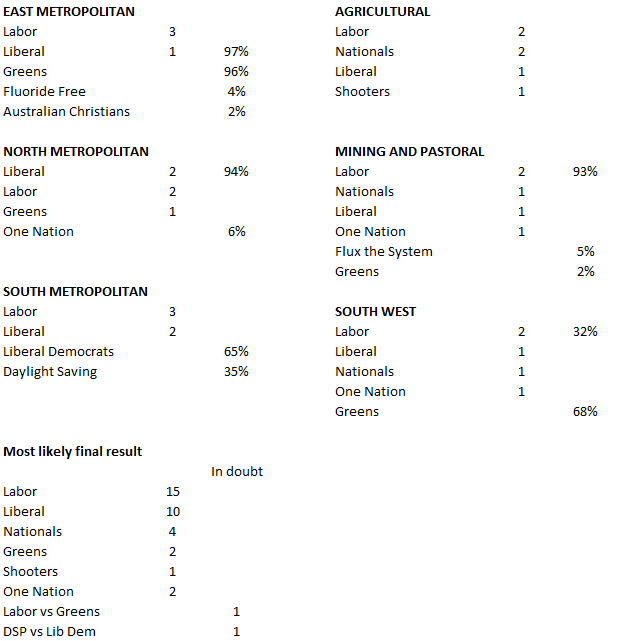
Wednesday night
Updated simulations below, with no fundamental change occurring anywhere on today’s counting. In South West, the key exclusion is at Count 20 on the ABC computer, at which the Greens are currently dropping out with 8.85% to Labor’s 9.20%. If the Greens were to finish ahead at this point, they rather than Labor’s #3 would win a seat.
Some idea on the progress count. Agricultural: 2760 counted today for a total of 69,793; 70.21% of enrolled voters counted, compared with a final total of 90.4% in 2013. East Metropolitan: 14,769 counted from a total of 276,487; 72.42% counted compared with 89.65% in 2013. Mining and Pastoral: 3124 counted today from a total of 37,644; 56.71% counted compared with 79.46% in 2013. North Metropolitan: 23,383 counted today from a total of 280,628; 73.66% counted compared with 89.69% in 2013. South Metropolitan: 15,195 counted today from a total of 285,401; 89.47% counted compared with 71.89% in 2013. South West: 7326 counted today from a total of 161,414; 73.72% counted compared with 90.67% in 2013.
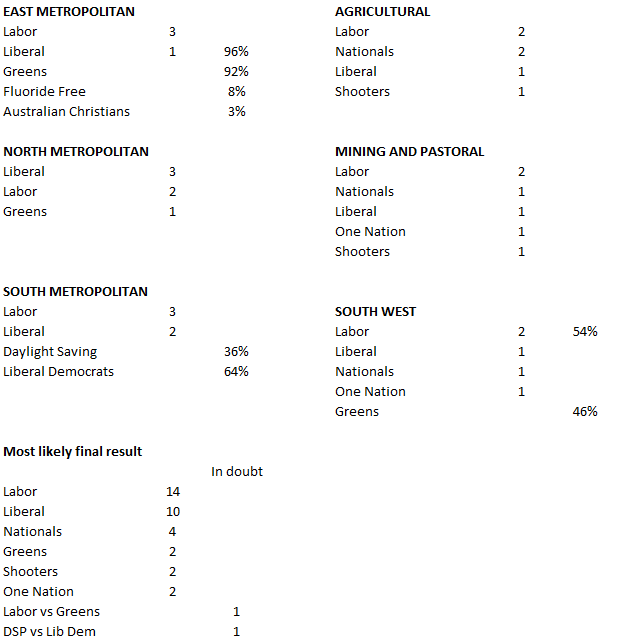
Tuesday night
Yesterday’s bad day for the Greens has been followed by a much better one today. After being written off in South West yesterday, they have today roared back after a drop in the vote share for Labor, and are now rated a 46% chance of winning the last seat at the expense of Labr’s number three. They are also up from 77% to 92% in East Metropolitan, where a win over Fluoride Free depends on the latter dropping out behind One Nation at the key exclusion. At present, the ABC projection has One Nation leading at the relevant point by 9.60% to 8.86%. There was little change today in the race between the Liberal Democrats and the Daylight Saving Party in South Metropolitan, with the former still slightly favoured. The challenge for the Daylight Saving Party is to survive an exclusion ahead of Australian Christians, in which case preferences would push them past the Liberal Democrats. However, the ABC projection presently has Australian Christians leading 3.94% to 3.72%.
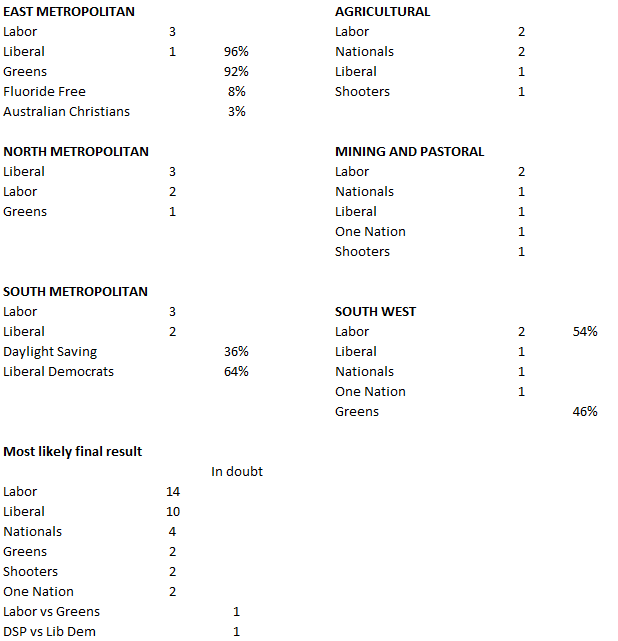
Monday night
Today’s run of my upper house count projections has produced a radical change in South West, where yesterday I had the Greens a 98% chance of winning the last seat versus 2% for Labor, but now I have it as all but a done deal for Labor. However, I now have the Greens slightly favoured in their race against Fluoride Free in East Metropolitan, which will come down to whether Fluoride Free can get their nose ahead of One Nation at the key cut-off point. I’ve arbitrarily halved the amount of variation I’m allowing for in randomising the results for purposes of my simulations, which has a lot to do with the fact that I’m listing clear-cut results in three of the six regions, and coming fairly close to doing so in Mining and Pastoral (though I’m told the Greens feel at least some cause for hope that below-the-line votes will get them up at the expense of Shooters).
As before, the table below lists “confirmed” seats in the left column and percentage changes of taking the remaining seat or seats (if any) in the second. The progress of yesterday’s count was as follows: 10,291 new votes in Agricultural, for a total of 60,682; 4476 in Mining and Pastoral, for 28,300; 15,426 in South West, for 126,801; 24,266 in East Metropolitan, for 234,477; 31,463 in North Metropolitan, for 236,862; 16,290 in South Metropolitan, for 236,885.
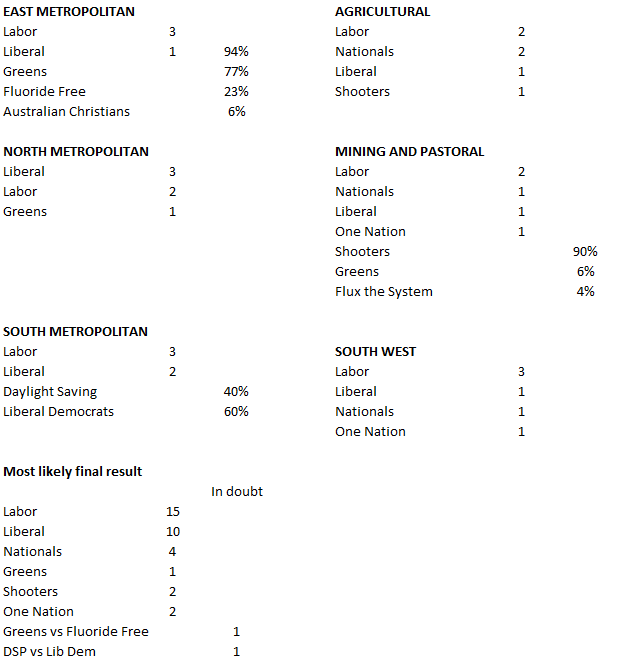
Sunday night
I’ve done another run of my simulations after today’s counting, of which there was a very great deal in Agricultural (from 13,315 votes counted to 50,391) but only modest amounts in North Metropolitan and South Metropolitan, with the other three regions coming somewhere in between (votes in the count increased by between 21% and 31%). I would probably have since this coming if I had done my homework carefully on where the outstanding votes were, but the Labor-Greens axis is looking weaker today due to a deteriorating position in East Metropolitan and Mining and Pastoral, with the latter now set to deliver a second seat to One Nation on top of their clear win in South West. The Liberals have gone from a weak chance for a second seat in East Metropolitan to a strong one, coming at the expense of either the Greens or Fluoride Free, both of whom looked strong yesterday and are now looking dicey. In Mining and Pastoral, yesterday it looked like Labor #3 or the Greens would win a third seat, but I’m now projecting that will likely go to One Nation instead, joining the Nationals, Liberals and Shooters on one seat apiece. This means a broadly conservative bloc of Liberal, Nationals, Shooters and One Nation stands to win exactly half the 36 seats, putting it in a position to win votes on the floor after Labor provides the President.
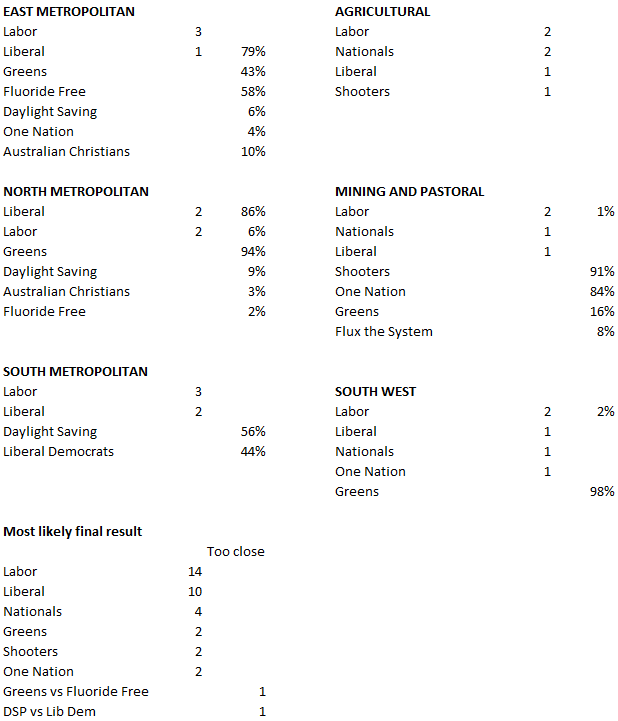
Saturday night
The Labor landslide looks to have carried over to a better-than-expected result in the Legislative Council, where Labor and the Greens seem likely to win half the 36 seats between them. Depending on how things pan out in Mining and Pastoral, that will be either Labor 15 and Greens three, or Labor 14 and Greens four. However, Labor will have to provide the President, who only gets a casting vote in the event of a tie on the floor, which tends not to happen because of the odd numbers once the President is taken out of the picture. So the government will need another vote on top of the Greens to get contentious measures through — including, perhaps, measures related to the reform of the chamber’s malapportionment and electoral system.
The Liberals look to have crashed from 16 seats to nine, while the Nationals are down from five to four. That leaves another five cross-benchers on top of the three or four Greens. As I write at the close of business, the ABC computer is crediting the Daylight Saving Party with a seat in Mining and Pastoral, but this is because it is misidentifying Stefan Colagiuri as the party’s candidate, when he is in fact from Shooters Fishers and Farmers, who appear set to win two seats. However, the Daylight Saving Party might yet win the seat the ABC is crediting to the Liberal Democrats in South Metropolitan. There are also non-trivial chances of other disturbances to the current picture. One Nation should at least win a seat in South West, and the micro-party preference network looks a good chance to deliver Fluoride Free a seat in East Metropolitan.
I’ve run simulations based on the current voting numbers with randomised variations to test for the likelihood that results will differ from those shown by the ABC calculator. These are shown below, with confirmed wins in the first column and probabilities of winning one of the outstanding seats in the second.
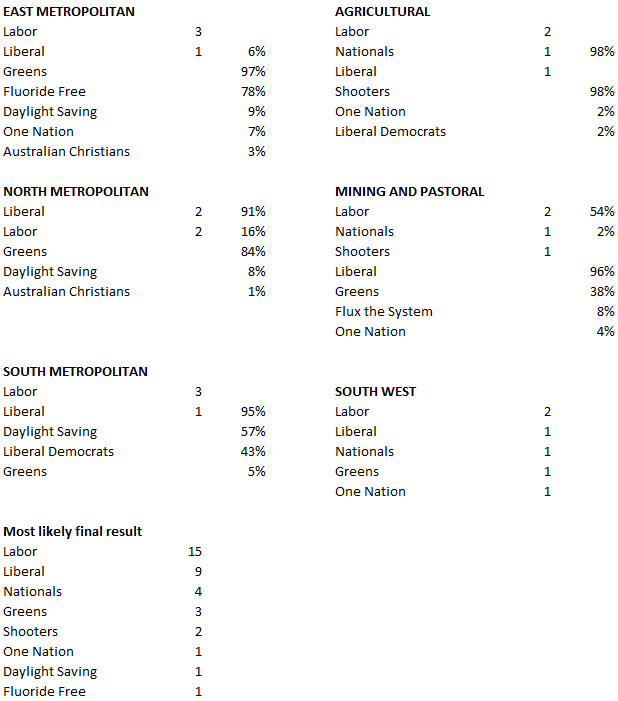
JaR – yes that sounds right. Chair should be part of the 19 votes needed.
[Given the massive malapportionment in the Senate, which is much larger than the WA Upper House, it’d be a bit strange for the WA situation to be ruled unconstitutional.]
I’m confused. The Senate can have malapportionment because that’s the way the Senate was designed in the constitution.
SW Metro has flipped from Labor to Green on the calculator but the margin is a meaningless 11 votes. The calculator doesn’t take account of BTL votes failing to follow the ticket (Labor is vulnerable to leakage but the Greens are more vulnerable to votes from other parties that aren’t above the line) so if it was stopped now either party might win by hundreds. One or the other may firm with more counting, or someone may have done detailed modelling to predict the drift of outstanding votes or the BTL patterns. I haven’t had time yet.
SW without the Metro of course 😉
William and Kevin,
The totals currently released by the WAEC are ticket vote totals only. There are currently no below the line votes included. That is an important point, especially in South West. In 2013 Labor’s state vote slipped 0.1% and the Greens rose 0.5% once below the line votes were included. The major change once below the lines are included is this small but potentially important shift in first preference support between Labor and the Greens. It may also boost the micro-parties, but some of that gain will then be lost by preference leakage.
The WAEC is using a counting procedure similar to the NSWEC where all below the line votes are tallied as a batch total rather than tallied by group. They don’t get included in the count until data entry is done. I am yet to get an answer whether data entered below the lines will be included in the export files used by the calculator
Looking at your table, below the lone votes would also improve LDP chances against Daylight Saving in south Metro, and Green chances versus the Liberals in East Metro.
Antony,
Good call re below the line votes. Note that in East Metro the ABC calculator shows both Greens and the second Liberal with a seat. The battle is the second Liberal vs One Nation which surprisingly is not mentioned in William’s simulation. A stronger Greens vote will help Liberals vs One Nation as Greens have preferenced Liberals higher.
Probably it is a three way race for two positions between Greens, second Liberal and One Nation.
I mentioned a stronger Greens vote will help Liberals vs One Nation as Greens have preferenced Liberals higher. That is if, as is currently the case, Greens obtain a quota first before Liberal and One Nation. Then their excess votes are transferred.
Lenxyz – think you will find it is the surplus votes of the groups who push the Greens over a quota that get sent on to others still in the race. Greens preferences only effective when Greens are eliminated. Not a good system – the surplus fractions should reflect all the votes which have elected a candidate.
Under the WA system, when a candidate reaches a quota their surplus is made up of votes in proportion to all votes held at the time they reached the quota. It is not like Tasmania, the ACT or NSW where only the last bundle is used, and it is not like SA, Victoria or the Senate where the weighting is done on ballot papers rather than votes.
Thanks for correction Antony. Actually only need to look at your LC calculator to see the surplus formula at work. Well done WA.
What a dog’s breakfast. I was skeptical on federal senate changes but I have to say reforms made it much more clearer and fairer.
ABC News is reporting that if Simon O’Brien of the Liberals gets up in South Metro that Labor will offer him the Presidency of the Legislative Council – and that the Liberals are worried he’ll accept! On the floor that would give Labor and The Greens 18 to everyone else’s 17.
Crikey’s Poll Bludger William Bowie asks “should Australia move tp a Proportional Representation system of government as used in Tasmania?”
https://www.crikey.com.au/…/poll-bludger-should-australia-…/
The simple Answer is NO.
Certainly not under the system of of counting Proportional Representation currently in use vote.
We would be better off adopting a Party List system then rhe flawed outdated preferential system used to elect the government in S\Tasmania or the host of upper houses including teh Senate.
The system in use was designed to facilitate a manual count and is a trade off of accuracy and reflection of the voters intentions to simply manual counting of votes.
With the use and adoption of computer based technology there is no justification to maintain the outdated method of counting proportional; representation.
We need to seriously consider adopting the Wright “Reiterative counting” system.
Wright uses a weighted Surplus Transfer based on the value of the vote not the number of ballot papers.
There is single transfer of votes per candidate. (No segmentation) The count is reset and restarted following the exclusion of any candidate from the count. Ballot papers are redistributed according to the voters expressed in intention and order of preference.
A quota for election is recalculated on each iteration of the count. No full value ever skips or jumps past a continuing candidate for election. No votes increase in value as the count progresses.
There also is no need to maintain the Droop Quota. Instead a fully proportional count (X/Y) can be adopted
The number of iterations continuing until all vacant positions a reelected in a single count iteration.
Above the line voting preferential voting can be retained with the number of above the line votes being equally distributed across all members of the group. This would remove the distortion in the system that currently disadvantages major parties and give an unfair advantage to minor groups/ A group having determined the order of its candidates ballot order would retain the right to nominate the order of exclusion within the group.being the reverse ballot paper order of the group. It would give true election of the voters choice unlike the mix match adopted by the Greens/Liberal party in the recent Senate voting reforms.
Unless we address this issue confidence in our system of government and elections will continue to be undermined.
The fix is simple. Unless we fix it and remove the distortions in the way the vote is counted, so it truly reflects the voters intentions, we should not expand it.